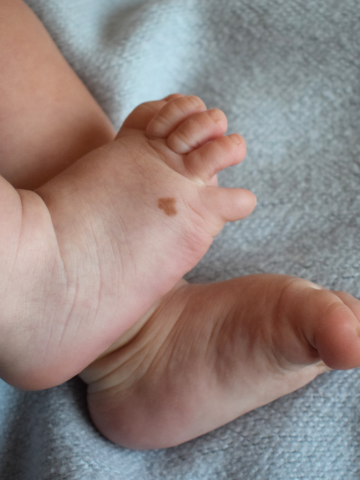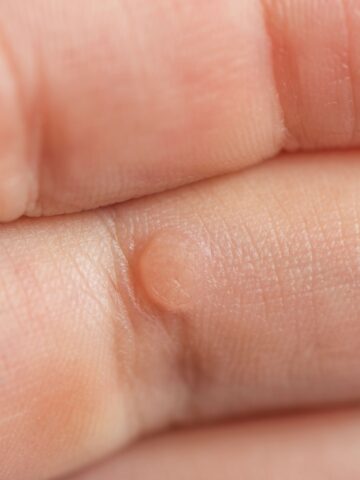Sun allergies, sun poisoning and other skin reactions from the sun in kids
Living in Southern California, we are lucky to experience beautiful sunny weather practically year-round. While we’re all aware of the dangers of sunburns, parents should be mindful of other skin reactions to the sun.
Here, Dr. Shireen Guide, pediatric dermatologist at CHOC, discusses common skin reactions caused by the sun, and how to prevent them.
Skin reactions to the sun in kids
Photosensitivity is an abnormal or adverse skin reaction to the sun that affects some children.
If your child develops a sunburn reaction, swelling or intense itching after limited exposure to sunlight, or shows a rash or scarring in a sun-exposed area (ie. face or neck), they may actually have photosensitivity.
There are a few common types of photosensitivity that affect some children, including:
Polymorphous or Polymorphic light eruption (sun allergies or sun poisoning) (PMLE)
Polymorphous light eruption (PMLE), also known as “sun allergy” or “sun poisoning” is the most common type of photosensitivity. It often occurs one to two days after intense sun exposure.
Sun allergies or sun poisoning occur at the beginning of summer or sometimes after a sunny vacation during which many hours were spent in the sun. It may range from small red dots to clear fluid-filled blisters (vesicles), eczema-like dry patches, or even circular (annular) target-like lesions.
What does a sun allergy or sun poisoning look like?
Reactions may range from child to child, but there are some common characteristics:
- Small red dots or spots on the skin, either scattered or clustered together in affected areas.
- Clear fluid-filled dots, or blisters, that may be itchy and uncomfortable.
- Eczema-like dry, scaly patches that may be rough, red and cause itching or burning sensations.
- Large raised bumps, sometimes circular, may be red, swollen and have a distinct border.
- Target-shaped or annular lesions, typically with a central red area surrounded by a paler ring and an outer red ring.
Polymorphic Light eruption most commonly occurs in the areas of sun exposure such as the face, neck, arms and legs. In children, it may start as very itchy bumps or dry patches, sometimes with small red dots.
Topical steroids and/or antihistamines may be helpful for symptomatic relief. Lesions often disappear in one to two weeks spontaneously, if no further sun exposure occurs.
Can my child develop a sun allergy?
Anyone can develop photosensitivity reactions if exposed to intense or prolonged sunlight, but certain kids may be more prone to sun allergies or other types of photosensitivity reactions. Here are some factors that can increase the risk:
- Family history: Children with a family history of sun allergies or other photosensitivity reactions may have an increased likelihood of developing these conditions themselves.
- Fair skin: Children with fair or light-colored skin have less melanin, which provides natural protection against UV radiation. As a result, they may be more susceptible to sunburns and other sun-related skin reactions.
- Medical conditions: Certain medical conditions can make children more susceptible to sun allergies. For example, kids with autoimmune disorders, such as lupus or dermatomyositis, are more prone to photosensitivity reactions.
- Medications: Some medications can increase the sensitivity of the skin to sunlight, leading to a higher risk of sun allergies. Common examples include certain antibiotics, non-steroidal anti-inflammatory drugs (NSAIDs), diuretics and certain antidepressants.
- Chemical sensitivities: Some children may have a heightened sensitivity to specific chemicals or substances found in sunscreens, skincare products, or even certain foods. These sensitivities can contribute to allergic reactions or exacerbate photosensitivity symptoms. For these kids, sunscreens that contain physical blockers such as zinc oxide or titanium dioxide may be better tolerated.
- Previous sun allergy or reaction: Children who have experienced a sun allergy or other photosensitivity reaction in the past are more likely to have similar reactions in the future.
Should my child see the doctor for sun allergies?
A child should see their pediatrician for sun allergies in the following situations:
- Severe or persistent symptoms.
- Worsening symptoms with each sun exposure.
- Impact on daily activities.
- Recurrent episodes.
- Unknown cause or diagnosis.
Your pediatrician may refer your child to a dermatologist who can evaluate the symptoms, provide a diagnosis and recommend treatment and preventive measures.
Solar urticaria
Solar urticaria is another type of photosensitivity characterized by hives, which show up as itchy red welts, usually after about 30 minutes or less of sun exposure. After several hours, the skin often returns to normal. This eruption generally does not last more than 24 hours.
The cause is unclear, but antihistamines, corticosteroids and limited sun exposure may all help relieve symptoms. Persistent symptoms may warrant further evaluation by a pediatric dermatologist.
Phytophotodermatitis
Phytophotodermatitis occurs when UV light reacts with certain chemicals in foods and creates an allergic or inflammatory reaction in the skin. This is especially common in sunny California, where serving lemonade outdoors may be a common scenario. Chemicals in certain foods can get on the skin and then react to the sunlight. The most common foods are limes, parsley, celery and figs.
The rash typically appears 24 to 48 hours after the exposure and ranges from dark spots, streaks to blisters. This rash often leaves dark marks or discoloration which may take weeks to months to disappear completely.
It may appear as a red itchy rash or show up as linear or angular streaks on the top of the arms or hands. It is usually in the pattern of exposure to the food causing the reaction, such as splattering or dripping from a squeezed lemon.
Medication-induced photosensitivity
Certain medications, such as antibiotics, antihistamines, nonsteroidal anti-inflammatory drugs (NSAIDs), and topical or oral retinoids (acne medication) can increase the skin’s sensitivity to sunlight. This can lead to a rash or sunburn-like reaction when the skin is exposed to the sun while taking these medications. It is important to be vigilant with sun protection if you are taking any medication which may cause sun sensitivity.
Actinic Prurigo
This is a hereditary form of photosensitivity that primarily affects Native Americans and those of Latin American descent. It usually starts in childhood and causes itchy, red bumps or blisters on sun-exposed areas. It may appear as itchy bumps on the face which flare with sun exposure, and symptoms may last for days to weeks. Any unusual or persistent rash associated with sun sensitivity should be further evaluated by a pediatric dermatologist.
Xeroderma Pigmentosum (XP)
XP is a rare genetic disorder in which DNA repair mechanisms are defective. This genetic disease makes the skin extremely sensitive to sunlight and puts these patients at high risk of developing skin cancers. They may experience severe sunburns, blisters, atypical freckling and dry, scaly skin.
Sunscreen can help prevent skin reactions to the sun
Dr. Guide reminds parents not to forget basic sunscreen practices, like:
- Using a water-resistant, broad-spectrum sunscreen (protecting against both UVA and UVB rays) with SPF 50 or higher. Sunscreens containing physical blockers such as zinc oxide or titanium dioxide may be a better choice for children with sensitive skin.
- Applying sunscreen 15 to 30 minutes before going outside and reapplying every 90 minutes, but more often if the child is swimming or sweating.
- Throwing away sunscreens that are old and passed the expiration date. Old sunscreens may no longer be effective and product degradation can result in adverse skin reactions or infections.
- Making sure to put sunscreen on often-forgotten areas such as the tops of the feet, ears and back of the neck and scalp.
- Consider using physical sunscreens that contain zinc oxide or titanium dioxide, as they provide a physical barrier against UV rays and are less likely to cause sensitivity in children prone to photosensitivity or allergies.
Tips for preventing sun allergies, sun poisoning and skin reactions to the sun
To prevent these skin reactions and protect your child from the harmful effects of the sun, Dr. Guide recommends some additional tips:
- Encourage your child to seek shade during peak sunlight hours, usually between 10 a.m. and 2 p.m., when the sun’s rays are the strongest.
- Dress your child in lightweight, protective clothing that covers their skin, such as long sleeves, long pants, and a wide-brimmed hat.
- Wear sunglasses to protect eyelids and eyes from harmful ultraviolet rays.
- Use additional protection measures like umbrellas or sun shelters when spending extended periods outdoors.
- Educate your child about the importance of sun protection and reapplication of sunscreens.
- Encourage good habits in kids through positive reinforcement of behaviors such as seeking shade, wearing protective clothing and applying sunscreen.
Featured pediatric expert
Dr. Shireen Guide
Dr. Shireen Guide is a board-certified pediatric dermatologist, and serves as assistant clinical professor and director of Pediatric Dermatology Resident Education at University of California Irvine School of Medicine, Department of Dermatology.

For more health and wellness resources from the pediatric experts at CHOC, sign up for the Kids Health newsletter.
Find a CHOC Primary Care Pediatrician
From babies to teens, pediatricians from CHOC’s Primary Care Network partner with parents to offer immunizations, sick visits, sports physicals and more.





